
This article appears in the February 2021 issue of Investment Executive. Subscribe to the print edition, read the digital edition or read the articles online.
Tax and financial planning experts are applauding a recent federal government proposal that would see the Canada Revenue Agency (CRA) automatically prepare tax returns for Canadian residents with simple tax situations.
“Most of the information that people provide on a tax return the CRA already has,” said Jamie Golombek, managing director of tax and estate planning with CIBC Private Wealth Management in Toronto. “Why should the average Canadian have to spend time and money hiring tax professionals to do their returns when the CRA [already] has the information?”
Alexandra Macqueen, a certified financial planner in Toronto, said she is “strongly in favour” of automated tax filing.
“[It] doesn’t need to mean that taxpayers are forced into the automated system,” Macqueen said, “but it could mean that low-income seniors are more readily able to access the benefits designed specifically for them.”
Canadian residents must file a tax return in order to receive benefits such as old age security and the guaranteed income supplement, Macqueen noted.
However, Aaron Wudrick, federal director of the Canadian Taxpayers Federation in Ottawa, argued that allowing the CRA to file returns is a conflict of interest for the agency. An individual taxpayer may want to consider ways to reduce their tax liability, while the CRA would have an opposing interest, Wudrick suggested.
“It’s right for people to wonder whether the CRA [is] going to give you more back or less [with automatic tax filing],” Wudrick said. “I think people assume it’s going to be less.”
The Liberal government announced its intention to introduce automated tax filing in its throne speech in September 2020. In a supplementary mandate letter issued in January, the Prime Minister’s Office directed Minister of National Revenue Diane Lebouthillier to “work with stakeholders and community organizations to continue to develop and implement free, automatic tax-filing services for simple returns to ensure Canadians receive the benefits they need.”
While the government has provided no details on how it defines “simple” tax returns or when or how the initiative would be rolled out, Golombek suggested the feds are interested in targeting low-income Canadians to be eligible for the service. “It would mostly be [aimed at] people living on government benefits,” he said.
In recent years, the Canadian government has introduced initiatives to help Canadians file returns, including funding tax-filing clinics and developing services such as Auto-fill My Return (which populates fields in tax-filing software with information the CRA already has) and File My Return (a telephone-based service for low-income tax filers).
About three dozen countries have incorporated some form of automatic or “return-free” filing into their tax regimes. However, various initiatives over the years to introduce automatic filing in the U.S. have been unsuccessful, with tax-preparation software providers playing a part in opposing them.
Automated tax filing in Canada would be a significant step forward in making sure those residents most in need will receive benefits, said Elizabeth Mulholland, CEO of Prosper Canada, a Toronto-based charity dedicated to promoting economic empowerment among low- and modest-income earners.
For low-income earners, a prefilled tax return may be a more attractive option than tax-filing assistance software that requires users to opt in for help, Mulholland suggested: “You’re going to get a much higher participation rate.”
Wudrick said that while the government’s proposal may be well-intentioned, the government’s efforts would be better spent on improving the CRA’s core services. “[The tax system] shouldn’t be so complicated that you require an automated tax filing,” he said.
An email to Investment Executive from Tax-Filer Empowerment Canada (TFEC), an industry association representing Canadian tax-preparation software providers, stated the best way for the federal government to encourage non-filers to file is to continue to work with software providers under the Digital Service Collaboration Plan (DSCP).
Under the DSCP, software providers commit to supporting the CRA’s digital services by incorporating those services into tax-filing products and services. The agreement also indicates the CRA does not plan to develop its own tax-preparation software.
The TFEC’s email didn’t state whether the association supports the government’s proposal for automatic tax filing, but it did say that the partnership between the industry and the CRA has enabled the government “to leverage industry’s unparalleled experience, expertise and innovation track record” to make filing easier and encourage more taxpayers to file.
Golombek said he hopes an automatic tax-filing service eventually will be extended to more than just low-income taxpayers. He envisions a system in which taxpayers would be sent a prefilled form and be able to add additional information, such as medical expenses or charitable donations, or make corrections before signing and returning the form to the CRA.
Automatic tax filing would mean less work for tax-return preparers, and “most accountants I know would welcome getting rid of the drudgery of tax-return preparation,” Golombek said. Tax professionals, he suggested, could instead focus on providing advice to clients with more complex financial situations, “adding enormous value instead of copying and pasting numbers.”